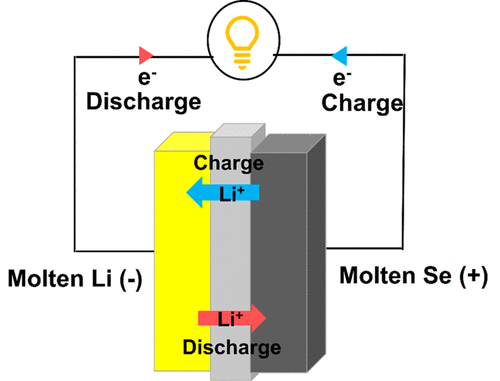当前位置:
X-MOL 学术
›
Energy Fuels
›
论文详情
Our official English website, www.x-mol.net, welcomes your
feedback! (Note: you will need to create a separate account there.)
Proof-of-Concept Molten Lithium–Selenium Battery
Energy & Fuels ( IF 5.2 ) Pub Date : 2021-12-01 , DOI: 10.1021/acs.energyfuels.1c03418 Ashish Gogia 1, 2 , Nicholas Vallo 1, 2 , Guru Subramanyam 2 , Joseph P. Fellner 3 , Jitendra Kumar 1, 2
Energy & Fuels ( IF 5.2 ) Pub Date : 2021-12-01 , DOI: 10.1021/acs.energyfuels.1c03418 Ashish Gogia 1, 2 , Nicholas Vallo 1, 2 , Guru Subramanyam 2 , Joseph P. Fellner 3 , Jitendra Kumar 1, 2
Affiliation

|
Most space missions utilize energy storage, such as a rechargeable battery onboard the spacecraft. Therefore, a continuing evolution of battery performance can benefit a wide gamut of space science missions conducted or planned by NASA and worldwide space agencies. Venus presents the most significant challenge to energy storage systems due to a combination of high temperature (465 °C) and the presence of corrosive gases (CO2, CO, SO2, and N2). On a NASA-funded project, a high-temperature (465 °C) lithium–selenium (Li∥Se) battery consisting of an anode of molten Li, a lithium-ion conducting ceramic electrolyte (garnet-type Li6.4Al0.2La3Zr2O12, LLZO), and a cathode of Se have been conceptualized. The proof-of-concept Li∥Se cells were built using baseline cell electrodes, electrolytes, and cell design. The fabricated Li∥Se cell was tested in an in-house built cell holder placed in an argon-filled glovebox. Electrochemical testing includes time-dependent open-circuit voltage measurements across a wide temperature range (230–500 °C) and electrochemical cycling at multiple current rates at 465 °C. Further cell components and design optimization will enable higher current charge–discharge and a longer battery life span over a wide temperature range. In addition, the use of high-energy electrodes will encourage long-duration and safe Venus surface exploration.
中文翻译:

概念验证熔融锂-硒电池
大多数太空任务都使用能量存储,例如航天器上的可充电电池。因此,电池性能的持续发展可以使 NASA 和全球航天机构执行或计划的广泛空间科学任务受益。由于高温 (465 °C) 和腐蚀性气体(CO 2、CO、SO 2和 N 2)的存在,金星对储能系统提出了最重大的挑战。在 NASA 资助的一个项目中,高温 (465 °C) 锂硒 (Li∥Se) 电池由熔融锂的阳极、锂离子导电陶瓷电解质(石榴石型 Li 6.4 Al 0.2 La 3 Zr 2 O 12, LLZO) 和 Se 的阴极已被概念化。概念验证 Li∥Se 电池是使用基线电池电极、电解质和电池设计构建的。制造的 Li∥Se 电池在放置在充满氩气的手套箱中的内部构建的电池架中进行了测试。电化学测试包括在很宽的温度范围 (230–500 °C) 内进行时间相关的开路电压测量和在 465 °C 下以多种电流速率进行电化学循环。进一步的电池组件和设计优化将在较宽的温度范围内实现更高的充放电电流和更长的电池寿命。此外,高能电极的使用将鼓励长期和安全的金星表面探索。
更新日期:2021-12-16
中文翻译:

概念验证熔融锂-硒电池
大多数太空任务都使用能量存储,例如航天器上的可充电电池。因此,电池性能的持续发展可以使 NASA 和全球航天机构执行或计划的广泛空间科学任务受益。由于高温 (465 °C) 和腐蚀性气体(CO 2、CO、SO 2和 N 2)的存在,金星对储能系统提出了最重大的挑战。在 NASA 资助的一个项目中,高温 (465 °C) 锂硒 (Li∥Se) 电池由熔融锂的阳极、锂离子导电陶瓷电解质(石榴石型 Li 6.4 Al 0.2 La 3 Zr 2 O 12, LLZO) 和 Se 的阴极已被概念化。概念验证 Li∥Se 电池是使用基线电池电极、电解质和电池设计构建的。制造的 Li∥Se 电池在放置在充满氩气的手套箱中的内部构建的电池架中进行了测试。电化学测试包括在很宽的温度范围 (230–500 °C) 内进行时间相关的开路电压测量和在 465 °C 下以多种电流速率进行电化学循环。进一步的电池组件和设计优化将在较宽的温度范围内实现更高的充放电电流和更长的电池寿命。此外,高能电极的使用将鼓励长期和安全的金星表面探索。































 京公网安备 11010802027423号
京公网安备 11010802027423号